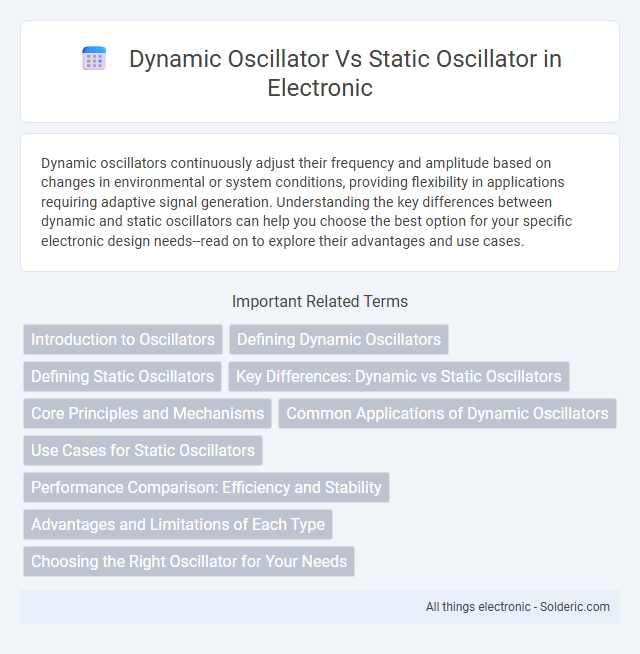Dynamic oscillators continuously adjust their frequency and amplitude based on changes in environmental or system conditions, providing flexibility in applications requiring adaptive signal generation. Understanding the key differences between dynamic and static oscillators can help you choose the best option for your specific electronic design needs--read on to explore their advantages and use cases.
Comparison Table
| Feature | Dynamic Oscillator | Static Oscillator |
|---|---|---|
| Definition | Oscillator with variable frequency or amplitude based on input or environment | Oscillator with fixed frequency and amplitude regardless of external changes |
| Frequency Stability | Variable, can adjust dynamically | Highly stable and constant |
| Use Case | Signal modulation, adaptive circuits, and frequency tuning | Clock generation, reference signals, and fixed-frequency applications |
| Complexity | Higher due to feedback and control mechanisms | Lower, simpler design |
| Examples | Voltage-Controlled Oscillator (VCO), Ring Oscillators with feedback | Crystal Oscillator, LC Tank Oscillator |
| Power Consumption | Typically higher due to active components | Usually lower, more efficient |
| Frequency Range | Wide, tunable over a range | Narrow, fixed frequency |
Introduction to Oscillators
Oscillators generate periodic signals essential for communications, timing, and signal processing. Dynamic oscillators rely on active components like transistors to sustain oscillations through feedback loops, making them adaptable and tunable. Static oscillators use passive elements such as crystals or resonators to maintain stable, fixed-frequency outputs, providing high precision and reliability for your design.
Defining Dynamic Oscillators
Dynamic oscillators are electronic circuits that generate oscillating signals by utilizing active components such as transistors or operational amplifiers, allowing frequency and amplitude to vary in response to external conditions. Unlike static oscillators, which rely on fixed reactive elements like capacitors and inductors to maintain a constant oscillation frequency, dynamic oscillators adapt their output through feedback mechanisms and parameter changes. This adaptability makes dynamic oscillators suitable for applications requiring frequency modulation, signal processing, and adaptive control systems.
Defining Static Oscillators
Static oscillators maintain a fixed frequency based on a stable feedback network, often using components like quartz crystals to ensure precise and consistent signal generation. They operate without altering their frequency in response to external factors, providing reliable timing in systems such as clocks, radios, and communication devices. Static oscillators contrast with dynamic oscillators, which adjust frequency dynamically based on circuit conditions or input variations.
Key Differences: Dynamic vs Static Oscillators
Dynamic oscillators adjust their frequency based on external factors such as voltage or temperature, providing flexibility in applications like adaptive signal processing. Static oscillators maintain a fixed frequency, offering stability and predictability critical for precise timing circuits. Your choice between dynamic and static oscillators depends on whether frequency adaptability or consistent performance is the primary requirement.
Core Principles and Mechanisms
Dynamic oscillators rely on time-varying parameters and feedback loops to generate oscillations, often leveraging nonlinear dynamics and energy exchange within the system. Static oscillators maintain constant system parameters and produce steady oscillations through inherent resonant modes or fixed frequency components. Understanding the core mechanisms highlights that dynamic oscillators adapt their frequency and amplitude actively, whereas static oscillators depend on stable, predefined circuit elements for sustained oscillation.
Common Applications of Dynamic Oscillators
Dynamic oscillators are widely used in applications requiring variable frequency control such as signal generators, modulators, and adaptive filters, enabling precise tuning to changing conditions. Their ability to adjust oscillation based on feedback makes them ideal for communication systems and sensor circuits where stability and adaptability are crucial. You can rely on dynamic oscillators for enhanced performance in environments demanding real-time frequency adjustments.
Use Cases for Static Oscillators
Static oscillators excel in applications requiring a fixed, stable frequency output such as clock generation in microprocessors, telecommunications systems, and radio transmitters. They maintain consistent performance under varying temperature and power conditions, making them ideal for precision timing in embedded systems and digital circuits. Their simplicity and reliability suit environments where frequency adjustment is unnecessary, ensuring low phase noise and high frequency stability.
Performance Comparison: Efficiency and Stability
Dynamic oscillators exhibit higher efficiency due to their ability to adapt frequency and amplitude in response to changing loads, resulting in lower power consumption and improved signal integrity. Static oscillators provide superior stability with fixed frequency outputs, making them ideal for applications requiring minimal frequency drift over time and temperature variations. Performance trade-offs between dynamic and static oscillators depend on the specific needs for efficiency versus long-term frequency precision in electronic and communication systems.
Advantages and Limitations of Each Type
Dynamic oscillators offer enhanced frequency stability and adaptability to environmental changes, making them ideal for applications requiring precise tuning and low phase noise. However, their complexity can result in higher power consumption and increased design challenges compared to static oscillators. Static oscillators provide simpler architecture with lower power requirements and ease of integration but often suffer from reduced frequency stability and limited adaptability to varying operating conditions.
Choosing the Right Oscillator for Your Needs
Choosing the right oscillator depends on the application's frequency stability and adaptability requirements. Dynamic oscillators offer frequency tuning and better performance in variable environments, making them ideal for audio synthesis and communications. Static oscillators provide stable, fixed frequencies suited for clocks and timing circuits where consistent output is critical.
Dynamic oscillator vs Static oscillator Infographic

 solderic.com
solderic.com